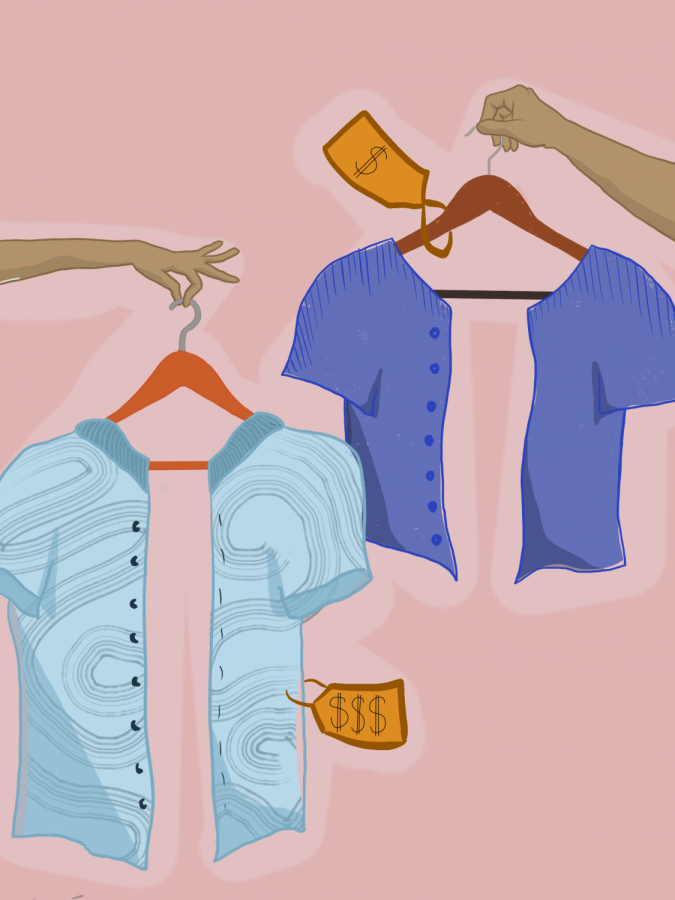The transition to thrifting: For better or worse?
Thrifting has become one of the most recommended and trendiest forms of shopping, as it helps restore our environment and our bank accounts. However, knowing thrift stores are oftentimes the only affordable option for lower-income families, staff writer Emilie Enser often feels guilty picking out items for herself.
Just a few years ago I, alongside nearly all the girls my age, begged my parents to buy me leggings that were over $100, simply for a brand logo that would be hidden under the back of my hoodie anyway. Now, just a few years later, I’m asking my parents if I can go out to look through the isles of used jeans and sweaters at our nearest thrift store, a store that sells second-hand clothing and other household items. Whether that’s due to growing into different styles of clothing or realizing the value of money, there’s no doubt that thrifting has gained popularity recently, particularly among Gen Z.
Thrifting has become one of the latest fashion trends, and is definitely reinforced by influencers online partly because of its environmental sustainability. With the large variety of styles from different decades, thrifting is where fashion and sustainability can come together.
At first, I thought this was wonderful: There’s finally a trend beneficial to both our wallets and our Earth. Many mainstream clothing companies have been called out for their inexcusable working conditions and wages, and fast fashion dominates the industry exploiting its workers and using cheap, toxic materials that have led it to become the second largest water polluter globally.
Even so, many of the businesses recognized for their sustainable fashion, such as Patagonia or Reformation, are quite expensive. For many, thrifting seems to be the perfect solution as an affordable, environmentally beneficial source of clothing. As more people buy second hand, problematic companies lose business and waste is drastically reduced.
However, there’s more to the trend to consider. As thrifting has started to become more mainstream, I start to worry that thrift stores will no longer be the resource for the financially underprivileged like they used to be. The more that financially privileged people take part in “thrifting hauls,” the less clothing is available for the people of lower economic status that genuinely need the cheaper alternative to shopping. Nevermind the fact that buying thrifted clothing in bulk pretty much defeats the entire purpose of avoiding the mass production of clothing that big businesses use.
Thrifting is becoming mainstream — both for acquiring unique pieces of clothing and for reselling on places like Depop, specifically made for reselling thrifted or used clothing, and I’m worried that this will make thrifted clothes less accessible for those that truly need it.
Reselling thrifting clothing is particularly unethical, making profit off of the cheaper clothing that many rely on. With the more recent change of demographics to wealthier customers, thrift stores can adjust their prices to what many are willing to pay, as Goodwill’s 2010 and 2020 value guides show. Reselling higher-priced thrifted clothing gentrifies thrift stores, leaving lower-income families behind.
This is especially true for plus-size clothing that is already less accessible in mainstream stores, and is particularly necessary for lower-income people that are oftentimes overweight. As oversized clothing is trendier than ever, I’ve seen a number of thrifting “tips,” like going into the XL Men’s section, in turn taking away the only option some people have.
In general, something about middle- and upper-class people traveling to lower-income areas in order to shop “trendier” makes me feel guilty.
At the end of the day, the movement of shopping from more ethical and environmentally friendly businesses truly is a good thing. We should stay away from big businesses that use cheap labor for the mass production of their items.
And, we all have the right to save money. Clothing gets expensive. If we have a cheaper option for good quality clothing through a process that is helpful to the environment and our money can get donated to charity, which thrift stores like Goodwill and Salvation Army do, by all means, we should all be able to take advantage. I just think it’s important for those of us who are better off to be considerate of the necessity of these thrift stores for some.
Buying second hand is a better alternative than supporting fast fashion businesses. So, it may be worthwhile to drive the extra miles to a privately owned thrift store. This way you can still get all the benefits of thrifting while understanding that many rely on bigger chain thrift companies. You can support a smaller business and help prevent inflating the cost of clothing that many need. Gen Z’s interest in making the world a better place is like no other, so while we make an effort in restoring the environment and calling out problematic companies, it’s important we each do our part in looking out for everyone.






Nits | Nov 7, 2021 at 11:01 am
Forgot to share that my son purchases those XL items from thrift stores.
Nits | Nov 7, 2021 at 11:00 am
One more thought that I have shared with my son who thinks it is cool to purchase XL items—several times per week. Major retailers have HUGE markdowns nowadays. You just have to know how to shop. I am not saying that shopping on-sale retail is a way to promote good wages and higher wages. But, it is one big way to save a lot of money.
Boe5 | Nov 6, 2021 at 10:30 pm
The problem is that thrift stores are now raising their prices now making their items unaffordable for those in need. Yes it was said. But I am afraid it is not actually being recognized…..there was a reason and need for the clothing to be $2.99 $3.99 and $4.99
Now shoes and pants that would last someone an extended amount of time due to the high quality which normally would cost an extreme amount is what one that needs to be frugal from the start for true reasons and would benifit from the true low cost but high quality items.
Nits | Nov 4, 2021 at 7:40 am
Thought I should point out that Goodwill, unlike Salvation Army, is a FOR-profit organization. It pays its executives high salaries. Just like corporate America.
Grace Kelly | Nov 4, 2021 at 5:12 am
You save one destroy clothing industry I shop old and new given them both a chance.
Sonia Brunner | Jan 11, 2021 at 10:37 am
This is an excellent article. It was well written and logically argued. Well done!